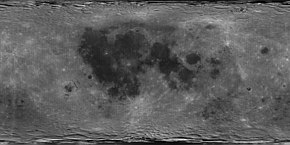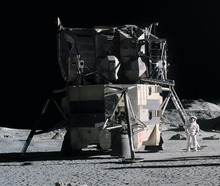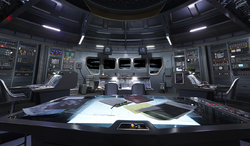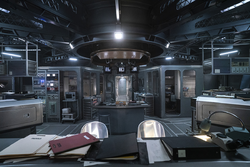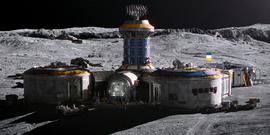Haller Base: Difference between revisions
No edit summary |
No edit summary |
||
| Line 192: | Line 192: | ||
==Operation== | ==Operation== | ||
===Crew stay=== | |||
The station was originally supposed to remain in operation for a total of ten years, but instead operated for almost twice the intended span. As a result, the older components of Haller Base, most notably the ''Falkenhall'' module, were often compared to a cramped and visibly used-looking "{{wp|labyrinth}}" with exposed technical equipment and hoses, as well as crowded with cargo; the modules added in the later development of the base were considerably more modern and new, as had been pointed out by crew members. | |||
The operation of Haller Base was subject to a stringent timetable and schedule as provided by the ground operators. The time zone used in Haller Base was Eastern Berean Time (EBT; {{wp|UTC+03:00}}). Due to the 3.5-day long {{wp|lunar day|lunar days}} and equally long {{wp|lunar night|lunar nights}} on the surface, certain measures were taken to re-create the temporal cycle as perceived on Aurorum, mainly for crew comfort and convenience, like covering windows during "night hours", dimming internal lighting, or adjusting light {{wp|colour temperature}}. While the morning and mid-day were reserved for work, exercise to combat {{wp|muscle atrophy}} and {{wp|spaceflight osteopenia}}, and {{wp|space food}} breaks, the evening could be used by crew members for recreational or other activities. Haller Base was supplied with a number of items to provide entertainment for astronauts in their spare time: books, films, a collection of pre-recorded music, and a guitar. Additionally, astronauts brought along their own personal belongings in a designated bag, which they stored in their crew quarters. | |||
Astronauts stayed and {{wp|sleep in space|slept}} in phonebox-sized soundproof booths, similar in appearance and style to {{wp|bunk bed|bunk beds}} onboard naval vessels. The crew quarters were equiped with secured trunks for personal belongings, shelfs, reading lamps, laptops, and a small window; the actual bed could remain un-tethered and horizontal due to Luna's noteworthy gravity. The designated galley area is located next to the quarters, which were mostly located in the H-2B CCSM, as is the area for sanitary and hygienic utilities, including three {{wp|space toilet|space toilets}} and a shower. The galley features three food warmers similar to a {{wp|microwave}}, two {{wp|refrigerator|refrigerators}}, a locked safe for alcoholic beverages (such as {{wp|cognac}}, {{wp|vodka}} and {{wp|whiskey}}) only accessible to the Expedition Commander, and a water dispenser. Despite the fact that crumbly food can be safely eaten due to the lack of weightlessness, most foods eaten in the base retain this quality, as vacuum sealed, frozen and freeze-dried food could be stored far longer for the long durations of Expeditions. Nevertheless, it is custom for arriving astronauts to re-stock the base with fresh vegetables and fruits, as well as sweets. | |||
===Transportation=== | |||
===Expeditions=== | ===Expeditions=== | ||
| Line 247: | Line 255: | ||
|- | |- | ||
|} | |} | ||
[[Category:Aurorum]][[Category:Solar System (Aurorum)]][[Category:Space exploration (Aurorum)]][[Category:Mascylla]][[Category:History of Mascylla]][[Category:History of Dulebia]] | [[Category:Aurorum]][[Category:Solar System (Aurorum)]][[Category:Space exploration (Aurorum)]][[Category:Mascylla]][[Category:History of Mascylla]][[Category:History of Dulebia]] | ||
Revision as of 20:09, 19 June 2022
This article is incomplete because it is pending further input from participants, or it is a work-in-progress by one author. Please comment on this article's talk page to share your input, comments and questions. Note: To contribute to this article, you may need to seek help from the author(s) of this page. |
Haller Base
Haller-Basis | |
|---|---|
| Haller Base–Lunar Research Station | |
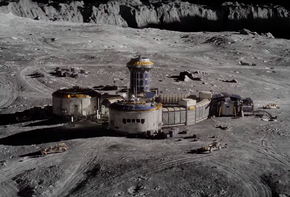 Haller Base facilities on the surface in 2008 | |
| Sovereign state | |
| Location on Luna | Jenssen crater, Soguichi Plateau |
| Administered by | Lunar Exploration Initiative of the |
| Established | 9 November 1987 |
| Retired | 15 February 2009 |
| Named for | Emil G. Haller |
| Population (1987 / 2008) | |
| • Total | 3 / 6 |
| Type of operation | |
| • Crew | All year-round |
| Operation | |
| • Status | Inoperational |
| Dimensions |
|
| Facilities | 9 buildings and facilities List
|
Haller Base, officially the Haller Base–Lunar Research Station (Hesurian: Haller-Basis Lunare Forschungsstation), is a Mascyllary research station on the sloped rim of the Jenssen crater in the Soguichi Plateau, on the surface of Luna, the second planet of the world's binary planet system. It was operated under the Lunar Exploration Initiative (MLEI) jointly of the MAOA and Air Force from 1987 to 2009 and is considered to be the furthermost point of Mascyllary jurisdiction and only one on Luna. The base is named in honour of rocketry pioneer and polar explorer Emil Haller who was a significant contributor to the foundation of the MAOA and its early human spaceflight projects.
Haller Base is the first modular planetary station and first large man-made structure on Luna, and was assembled by over multiple subsequent manned missions from 1987 to 1999. The original base, less than a fifth of the completed station's volume and named Falkenhall, landed as part of the Sigma-Haller Expedition on 9 November 1987 by the space agencies of Mascylla and Dulebia as part of the Sigma program. With the Haller 87 and Haller 88 missions, the base became the first continuously inhabited research station on Luna and still maintains the longest duration of continuous human presence in space at 4,018 days. Since, the station has hosted up to 82 astronauts, the largest number for any Lunar research station, and has repeatedly been partially rebuilt and expanded upon. By 2008, Haller Base encompassed five pressurized modules, and two unpressurized components, the H-5E Unpressurized Multipurpose Module and the power-supplying photovoltaic array on the surface.
The station was purposefully constructed and ultimately served as a research laboratory which enabled crews to conduct scientific experiments on human biology, microgravity and radiation physics, astronomy, meteorology and space physics, as well as study the effects of long-term stay in space on humans. While the base operations and crew were militaristic in nature, it allowed scientific endeavours such as international collaborations with other countries to access the station. Haller 87 sustained three crew members, but the station's population continued to grow through its operation, with a peak six crew members of Haller 2000 and later 04 simultaneously on the station. In service from 1987 to 2009, Haller Base continued human presence on Luna, before it was agreed upon by the MLEI to retire the station in February 2009 mainly due to its aging hardware, damages sustained by meteorological phenomena and regolith exposure. The station has since been unoccupied and plans to either repurpose it for another settlement or preserve it as a protected area have been put forward.
Structural history
Original base (1987–1989)
Construction and Sigma-Haller Expedition
The initial first component of the station, the pressurized Falkenhall Main Service Block (Hauptbetriebsblock; MSB) module and its adjacent solar arrays measuring 4,000 m2 of operable area, were manufactured at the Gräbler Spaceflight Center near Rothenau, Aldia, beginning in 1982. The name Falkenhall was ultimately chosen by MAOA in reference to the oldest continuously inhabited urban settlement in modern-day Mascylla, having been founded by 600 BC. The modules were delivered on ship to the Spacecraft Processing Facility and Main Flight Operations Building at Cape Weimud Space Center in Akawhk in August of 1987 for final inspections, processing and preparation for launch. The module was designed with three docking ports suitable for berthing operations, three autonomous arrays of solar cells measuring 4.5 by 1.3 meters (14.7 by 4.3 feet) mounted on its roof, six nickel-cadmium batteries with a capacity of 4 kilowatts of power, ten externally mounted fuel tanks holding 8.8 tonnes of propellant, and is outfitted with early communications and control equipment. Falkenhall has a dry mass of 21,492 kilograms (47,382 lb), is 8.2 meters (26.9 ft) long and 4.1 (13.5 ft) meters wide.
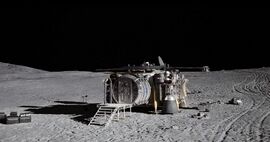
Falkenhall was launched on 6 November 1987 on a purpose-built and modified version of the Atlant-3 rocket from Cape Weimud in Akawhk; the mission was incorporated into the Sigma program as the Sigma-Haller Expedition, crewed by a joint Dulebian-Mascyllary crew of Mission Commander Janus Heine. After the initial launch and the first two stage separations, the payload ascended to a 500 km (311 mi) high parking orbit. Eight hours later, the crew of the Sigma-Haller Expedition was launched to the cargo stage waiting in orbit on an Atlant-4G, and performed a subsequent space rendezvous. The spacecraft complex was manned for re-configuration and trans-lunar flight preparations before firing the CSM third upper stage for trans-lunar injection on 7 November.
On 9 November, the two-stage Falkenhall module and its cargo load, referred to as LM-13 Dnepr, separated from the Sigma Command and Service Module (Kommando- und Betriebsmodul; CSM) Antares, having ferried it to lunar orbit, and descended to Luna's surface; Dnepr touched down at the ridges of Jenssen crater of the Soguichi Plateau at 05:22 UTC. The three astronauts of the resident crew stayed on the newly established lunar base before returning to the CSM in low orbit; the base module served as the launch pad for the ascent stage, similar in operation to the Sigma Lunar Module (Lunarmodul; LM), which then docked with CSM-98 Antares again and was subsequently discarded. After 6 days of stay and the 4 days of travel following the trans-Aurorum injection, the crew of the Sigma-Haller Expedition returned to Aurorum on 18 November.
Complications and modification
The ascent stage of Dnepr inadvertently polluted the photovoltaic arrays with whirled up lunar regolith, which caused Falkenhall to suffer a blackout one day after Sigma-Haller's departure. Contact to the automatic systems of the station remained severed until the Haller 87 Expedition was able to clean and re-orientate the solar arrays while moving them 700 meters (2,297 feet) away from the designated but improvised landing and take-off site, two weeks later in December of 1987. During the Haller 88 Expedition in July of 1988, a repurposed descent propulsion system similarly used in the LM descent stage was utilized to blow away possibly hazardous or inhibiting regolith from the designated site and heat the material to fuse it into a durable and hardened platform. After installing edge and status lighting, LM-17 Heiserer of the Haller 89 Expedition was the first to land on the Sahalinov Landing Site (Sahalinow-Landungsplatz; SLS); in 1994, a second SLS including seven additional external fuel storage tanks were constructed 30 meters (98.4 ft) away from the first SLS.
Added modules (1989–1999)
Assembly
The construction of Haller Base was a major and ultimately multi-national undertaking in space and lunar architecture. The initial assembly began in November 1988 during the Haller 89 Expedition when two Base Node Module Adapters (Basisknotenmoduladapter; BNMAs) were attached to the passive Falkenhall module by two astronauts performing extra-vehicular activities, serving as nodes for future additions. Over the course of Haller Base's assembly, astronauts used some 1,100 hours of EVA operations as well as the Mobile Servicing Robotic Unit (Mobiles Betriebsrobotikeinheit; MSRU) as the base expanded in size and complexity. Similarly, since the Haller 92 Expedition, Haller Base was serviced and supplied by an evolved and heavy-payload five-astronaut version of the 1980s Sigma LM, the Lunar Surface Access Module (Lunares Modul für Oberflächenerkundung; LSAM); because the first active LSAM was LM-19 Fischadler, it is sometimes referred to as Fischadler (meaning "Osprey") by itself.
Elements
On 30 July 1989, the H-2B Crew Compartment and Science Module (Truppenabteil und Wissenschaftsmodul; CCSM) was launched into orbit and then delivered to Luna via the Haller 90 Expedition. The H-2B–Sagittarius vehicle performed the descent and docking to the Falkenhall-BNMA complex part-automatically and part-manually. Serving as the new operational centre of Haller Base, the H-2B module's computer system autonomously assumed control over the base from Falkenhall's systems, and was equipped with designated crew and sleeping quarters, a kitchen, multiple toilets and sanitary systems, and exercise equipment. Additionally, the scientific compartment of the large cylindric module, measuring 13.3 meters (43.6 ft) in diameter, supplemented the Falkenhall life-support systems with CO2 scrubbers, dehumidifiers, wastewater treatment systems, and oxygen generators. It also comprises the central command and operations room of the base. Mission Commander Felix Ahrndt later recalled the happiness and gratitude of subsequent Haller Expedition astronauts who stayed in the base before the expansions in 2011, commenting: "By this point Falkenhall was, well, "overcrowded" would be an understatement. It was like a tan of sardines, speaking from experience and talking to other Haller astronauts, and everyone talked about how happy they were that they now could take more than eight steps in any direction. H-2B was like a cathedral in comparison to the old Falkenhall lady." In 1991, H-2B was officially renamed to Aufgang (meaning "Dawn").
Over the next four years, Haller Base continued to expand. During the 1991 Haller 92 Expedition, the H-3 Science Module (Wissenschaftsmodul) was delivered to Luna as the primary new facility for research payloads, scientific experiments and medical life-support operations. The 23.1-tonne (50,927 lb) heavy research and experimental laboratory is identical in layout and design to the H-2B Aufgang module and was permanently berthed to it on 29 January 1992, and has since been the location of active research on Haller Base, encompassing studies and experiments relating to medicine, biotechnology, materials science, and other fields of physics. Aufgang was used frequently by international teams of scientists and for scientific research contributions of participating states, most notably Lavaria and Dulebia, in the form of experiments and delivered technology.
In 1994, the Haller 94 Expedition contributed the Main Airlock Module (Hauptluftschleusenmodul; MAM) to the base, intended to relieve Falkenhall's forward airlock system of potentially damaging over-use; before the addition of the MAM, EVAs could only be performed through the forward door of the first module, and an almost fatal accident during the Haller 93 Expedition on 2 September 1993 involving astronaut Lukas Krausmann highlighted the frequently used airlock's strain. It provided the base's capability of EVA operations on the lunar surface and was attached to Haller Base inbetween the Aufgang and H-3 modules. In order to alleviate the issue of the rapidly deteriorating performance of airlocks due to regolith exposure, the airlock, being 4.2 meters (13.7 ft) in diameter and 7.9 meters (25.9 ft) long, comprises two separate passageways, one from which astronauts can exit the base, and a smaller hatch for equipment storage and to clean used EVA suits of regolith, as well as nitrogen to mitigate post-spacewalk decompression sickness.
Two additional BNMAs and a more compact version of the H-2B and H-3 modules serving as a central node for the newer Haller Base complex, the H-4 Utility Node Module (Nutzknotenmodul; UNM), were delivered on the Haller 96, 97 and 98 Expeditions. The UNM accommodates additional sleeping quarters and sanitary systems for astronauts, and more importantly, houses vital electrical power storage units, areas for cargo holds, and controls for the base's electronic system; the addition of the UNM was in response to the base's rapidly increasing power consumption and ineffective control of power-generating capabilities from Aufgang, as was the installation of another 980 m2 (10,549 sq ft) of photovoltaic arrays outside Haller Base in 1997. During the Haller 98 Expedition in 1998, Haller Base was outfitted with 197 plates of a composite secondary hull consisting of stainless steel, kevlar and aluminium alloy to protect it from micrometeoroids.
The final expansion of the base to this date, the H-5E Unpressurized Multipurpose Module (Druckloses Mehrzweckmodul; UMPM), was brought to Luna in March of 1999 by the Haller 2000 Expedition. The UMPM was vertically mounted on top of the zenith docking port of the H-4 UNM, requiring 18 separate EVAs over the span of 48 hours and two specialized aerial work platforms. Once completed, the UMPM raised the total height of Haller Base to 17 meters (55.8 ft), and was added with the scientific experiments and devices intended for the module in the Haller 2000 and 01 Expeditions: the Wilhelm G. Neumayer Astronomical Observatory (Astronomisches Observatorium Wilhelm G. Neumayer; WiGNAO), Atmospheric and Lunaological Research Observatory (Atmosphärisches und Lunaologisches Forschungsobservatorium; ALRO), Angular Cosmic Interferometer (Kosmisches Winkelinterferometer; ACI), Lunar Muon and Neutrino Detector Array (Lunares Myon- und Neutrinodetektorfeld; LUMONDA), and Lunar Magnetic Spectrometer (Lunares Magnetospektrometer; LMS). WiGNAO is an astrophysical observatory equiped with an iliosar telescope, x-ray, extreme ultraviolet and Hα spectroheliographs, and a coronagraph intended for space weather prediction and x-ray astronomy; ALRO, also being an observatory, was used for observational astronomy, as well as imaging spectroscopy, energetic neutral atom imagery and mass spectrometry of Luna's surface and faint atmosphere. ACI observed the power spectrum, polarization and temperature anisotropies of the cosmic microwave background (CMB) to survey galaxy clusters, whereas LUMONDA was a high-energy neutrino observatory and the LMS magnetic spectrometer investigated antimatter amounts in cosmic rays.
Completed state (1999–present)
By February of 2009, Haller Base consisted of five pressurized and two unpressurized modules. Following the announcement of the program's retirement, the last resident crew onboard the base, the Haller 09 Expedition, celebrated its continuous operation and deactivated its life-support system upon the crew's departure on 15 February. The numerous scientific experiments in the UMPM continued to be used by scientists on Aurorum and relay research data for another four years, until the base's central computer was commanded to go on stand-by in 2013. While Haller Base has not been in activation ever since, as of 2022, the photovoltaic arrays and electronic systems are still considered to be fully operational if activity were to be resumed. However, in 2019, multiple micrometeoroids damaged the parabolic communications antennae on Aufgang's outer hull, thus impairing direct communication to and from Aurorum.
International cooperation
The Mascyllary Lunar Exploration Initiative included a formal provision, the Lunar Base Joint Use Intergovernmental Agreement (LBJUIA), which allowed members and citizens from interested countries (eight in total) to participate in crewed spaceflights to Haller Base and contribute scientific experiments or other payloads to regular Expeditions. However, the LBJUIA does not govern nor specify the legal foundations of the programme and the base itself, and because no other to-date convention of international law governing formal jurisdiction on Luna is in effect, Haller Base is de facto a stateless property on territory akin to international waters; simultaneously, it is generally accepted to be subject to Mascyllary legal jurisdiction (the only country to de jure govern territory outside Aurorum, but not exercise sovereignty), despite the lack of any formal convention or agreement.
Participating countries
Astronauts
Various Berean and Pamiran astronauts visited Haller Base over the course of the LBJUIA's existence and its operation, in order:
- Wladimir Selyov – during the 1987 Sigma-Haller Expedition
 People's Republic of Dulebia
People's Republic of Dulebia - Balduíno Miranda – during the 1992 Haller 92 Expedition
 Lavaria
Lavaria - Corin Côté – during the 1996 Haller 96 Expedition
 Sarrac
Sarrac - Kirill Antonov – during the 1997 Haller 97 Expedition
 Dulebia
Dulebia - Tuomo Mäkinen – during the 1998 Haller 98 Expedition
 Valimia
Valimia - Estevão de Mascarenhas – during the 1999 Haller 99 Expedition
 Lavaria
Lavaria - Radomil Borisov – during the 2000 Haller 2000 Expedition
 Dulebia
Dulebia - Valquíria Costa – during the 2001 Haller 01 Expedition
 Lavaria
Lavaria - Felix Kirchhöfer – during the 2002 Haller 02 Expedition
 Temaria
Temaria - Lidiya Vinogradova – during the 2004 Haller 04 Expedition
 Dulebia
Dulebia - Claudette Tremblay – during the 2005 Haller 05 Expedition
 Sarrac
Sarrac - Deodato Araújo – during the 2008 Haller 08 Expedition
 Lavaria
Lavaria
Operation
Crew stay
The station was originally supposed to remain in operation for a total of ten years, but instead operated for almost twice the intended span. As a result, the older components of Haller Base, most notably the Falkenhall module, were often compared to a cramped and visibly used-looking "labyrinth" with exposed technical equipment and hoses, as well as crowded with cargo; the modules added in the later development of the base were considerably more modern and new, as had been pointed out by crew members.
The operation of Haller Base was subject to a stringent timetable and schedule as provided by the ground operators. The time zone used in Haller Base was Eastern Berean Time (EBT; UTC+03:00). Due to the 3.5-day long lunar days and equally long lunar nights on the surface, certain measures were taken to re-create the temporal cycle as perceived on Aurorum, mainly for crew comfort and convenience, like covering windows during "night hours", dimming internal lighting, or adjusting light colour temperature. While the morning and mid-day were reserved for work, exercise to combat muscle atrophy and spaceflight osteopenia, and space food breaks, the evening could be used by crew members for recreational or other activities. Haller Base was supplied with a number of items to provide entertainment for astronauts in their spare time: books, films, a collection of pre-recorded music, and a guitar. Additionally, astronauts brought along their own personal belongings in a designated bag, which they stored in their crew quarters.
Astronauts stayed and slept in phonebox-sized soundproof booths, similar in appearance and style to bunk beds onboard naval vessels. The crew quarters were equiped with secured trunks for personal belongings, shelfs, reading lamps, laptops, and a small window; the actual bed could remain un-tethered and horizontal due to Luna's noteworthy gravity. The designated galley area is located next to the quarters, which were mostly located in the H-2B CCSM, as is the area for sanitary and hygienic utilities, including three space toilets and a shower. The galley features three food warmers similar to a microwave, two refrigerators, a locked safe for alcoholic beverages (such as cognac, vodka and whiskey) only accessible to the Expedition Commander, and a water dispenser. Despite the fact that crumbly food can be safely eaten due to the lack of weightlessness, most foods eaten in the base retain this quality, as vacuum sealed, frozen and freeze-dried food could be stored far longer for the long durations of Expeditions. Nevertheless, it is custom for arriving astronauts to re-stock the base with fresh vegetables and fruits, as well as sweets.

